Adi 222 Israeli IDF military Shayetet 13 Navy S. Force Ana-Digi Diver 200m watch
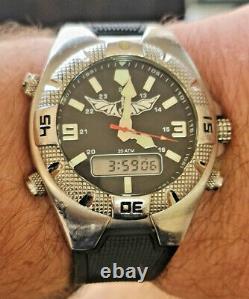
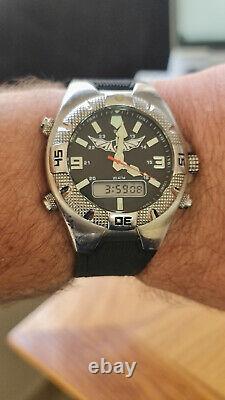
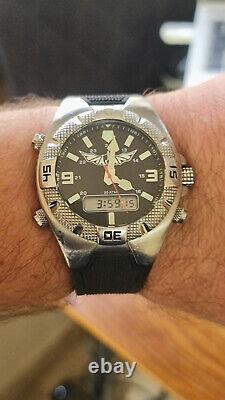
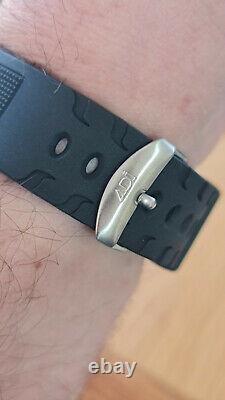

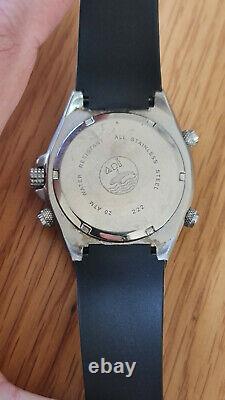
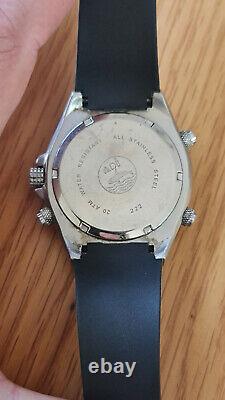
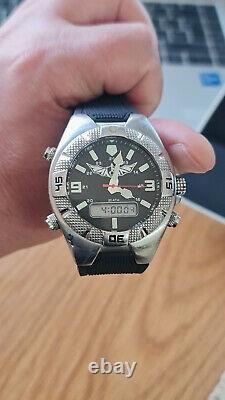


Adi 222 Israeli IDF military Shayetet 13 Navy S. Force Ana-Digi Diver 200m watch - is running. Very rare and collectable watch. Shayetet 13 fighters on time of unit course completing.
Flotilla 13 is a unit of the Israeli Navy. And one of the primary sayeret (reconnaissance). Units of the Israel Defense Forces. Shayetet 13 specializes in sea-to-land incursions, counter-terrorism. The unit is trained for sea, air and land actions. The unit has taken part in almost all of Israel's major wars, as well as other actions. The unit is one of the most secretive in the Israeli military.The details of many missions and identities of active operatives are kept highly classified. The unit is respected as among the best of the world's special forces.
And is compared to the US Navy SEALs. And Britain's Special Boat Service. Unlike many other Israeli Special Forces Units. Which take men only for their 36-month mandatory service. Volunteers for Shayetet 13 must agree to service at least four and a half years (18 months over and above the normal commitment).
Unit's Motto: As the bat emerges from the darkness, As the blade cuts through with silence, As the grenade smashes in rage. " In addition the unit is also referred to as "people of silence. New Original Adi Glass+ rezin Band. The case have micro stretches. Very Rare Collectable military watch.
Original Adi rezin band >signes of usage. What you see that you get. Founder of the Shayetet 13, and sixth commander of the Israeli Navy.Shayetet 13 with the symbol of the Palmach in the former Palyam base in Caesarea. Shayetet 13 is a veteran Israeli special forces unit. It was formed in 1949 by Yohai Ben-Nun. With men drawn from the ranks of the Palyam.
The naval branch of the Palmach. The elite fighting force of the Haganah.The ancestor of the Israel Defense Forces. The need for such a dedicated unit was a matter of debate during the early years of the IDF, and the unit subsequently suffered size and budget restrictions.
Upon its foundation, the existence of Shayetet 13 was a state secret, and its members wore general Israeli Navy insignia rather than their own unique one. IDF Chief of Staff Tzvi Tzur.
Inspects graduates of the Shayetet 13 training course, 1963. Shayetet 13 commandos participated in the 1956 Suez Crisis. They performed several failed reconnaissance missions before the war and later participated in the land campaign as regular soldiers.
A plan for Shayetet 13 commandos to capture an Egyptian Navy. Frigate was almost put into action.
The plan was called off because the elite unit's soldiers were deemed too valuable to risk for low-priority targets. In 1957, Shayetet 13 began to jointly train with the French Marine Commandos. And as a result, information about its existence began to leak.Two years later, the unit's soldiers were permitted to wear their distinctive bat insignia, and the existence of the unit was made public the year after that. In the late 1950s, Shayetet 13 commandos carried out a series of reconnaissance missions to monitor the deliveries of Soviet gunboats to Syria and monitor Lebanon during the 1958 Lebanon crisis. On July 9, 1958, Shayetet 13 operatives infiltrated Beirut. They were spotted and had to retreat, swimming back out to sea where an Israeli Navy torpedo boat picked them up and exchanged fire with a Lebanese patrol craft that intervened.
The Israelis were able to retreat without any casualties. In 1962, it participated in a joint operation with the Golani Brigade.
Against Syrian positions in the Golan Heights. In retaliation for Syrian firing on Israeli fishermen. While the Golani force was successful, the Shayetet 13 force failed to complete its mission, a raid on a Syrian post in Kursi. And retreated without casualties after coming under fire.
The fiasco became known as "Operation Rabbit". In August 1966, the unit was given the mission of retrieving the wreckage of a Syrian Air Force.
That had been shot down and crashed into the Sea of Galilee. Near the end of the operation, Syrian troops opened fire, and the salvage rope attached to the aircraft was dropped. The Syrians were later able to pick it up and drag their aircraft to safety.
Shayetet 13 operators in the Suez Canal area, July 1967. During the 1967 Six-Day War. The unit was tasked with neutralizing enemy fleets. Shayetet 13 commandos infiltrated Port Said. Six divers were captured and taken prisoner, and released in January 1968. Several other missions also failed. In July 1967, Shayetet 13 commandos crossed the Suez Canal. And blew up an Egyptian rail line in two places. The operation was carried out in retaliation for Egyptian shelling. Shayetet 13 participated in the operation. The operation was carried out in daylight, and the Egyptians opened fire from their positions, sinking a boat.Shayetet 13 saw extensive action in the War of Attrition. It carried out repeated commando raids in the Suez Canal. Area, often assisting Sayeret Matkal. Throughout 1969 the unit carried out a series of land-based mining, maritime patrol, and sabotage missions. On the night of June 21, 1969, Shayetet 13 carried out Operation Frenzy 5.
After a preliminary reconnaissance mission by a Shayetet 13 team a month before, a force of commandos attacked an Egyptian guard post after landing from the sea, killing 32 Egyptian soldiers and blowing up five buildings, with the only Israeli casualties being two commandos slightly injured. In July 1969, the unit successfully carried out the Green Island raid. In cooperation with Sayeret Matkal. Three of the six Israeli soldiers killed during the operation were Shayetet 13 operatives. The Egyptians lost approximately 80 soldiers. On September 7, 1969, Shayetet 13 carried out Operation Escort. Raiding the Egyptian anchorage at Ras Sadat. And destroying a pair of Egyptian P-183 torpedo-boats.Three commandos were killed on the way back from the mission when one of their charges detonated. Escort, nevertheless, allowed the IDF to carry out Operation Raviv. A highly successful 10-hour raid on Egypt's Red Sea. During the 1970s, the unit underwent a reorganization, with more emphasis placed on sea-to-land incursions and on effective training.
More issues rose with other IDF Special Forces units, which at the time suggested that Shayetet 13 should only provide the transportation to the target and assistance in crossing water obstacles, while leaving the surface warfare to the other IDF Special Forces. In 1970, in response to the persecution of Syrian Jews and their efforts to flee to Israel, the Israeli government launched Operation Blanket to bring them to Israel. In an operation directed by the Mossad. Lasting a few years, Shayetet 13 commandos and Mossad agents made dozens of clandestine incursions into Syria, with the participants having to resort to living undercover in Damascus. The operation succeeded in bringing only a few dozen young Jews to Israel. Shayetet 13 took part in Operation Spring of Youth.In 1973, in which Israeli special forces raided Beirut. And killed several members of Black September. The terrorist group which carried out the Munich massacre. Of Israeli athletes in the Munich 1972 Summer Olympics. The Shayetet 13 force that participated in the operation landed in north Beirut and destroyed a small Fatah.
During the Yom Kippur War. Shayetet 13 commandos infiltrated Egyptian ports numerous times, sinking five Egyptian naval vessels and heavily damaging another. Two commandos went missing during one of the raids. Operation Bardas 20 took place on January 14, 1971, to neutralize a guerrilla base in Lebanon.
Where about two dozen militants were training as frogmen. During the operation, the commandos destroyed some of the camp's buildings, and a number of guerrillas were wounded, including commander Abu Youssef. Shayetet 13, Unit 707, and Sayeret Tzanhanim. Commandos jointly raided guerrilla bases in Nahr al-Bared. On February 19, 1973 in Operation Bardas 54-55. During the operation, about 40 guerrillas were killed and 60 wounded, and a Turkish. Military trainer was taken prisoner. In the years following the Yom Kippur War. Shayetet 13 carried out various missions against guerrilla boats and those who assisted them, with mediocre success. In 1978, Shayetet 13 carried out ambushes, killing a senior enemy commander in one of them.From 1979 to 1981, the unit carried out 22 successful raids against guerrilla targets in Lebanon. The successes resulted in a unit decoration.
In one notable raid on April 19, 1980 Shayetet 13 commandos raided the base of a guerrilla organization that according to intelligence was planning an attack on a community in Israel, killing about 15 guerrillas, including the commander of the would-be infiltration unit and two of its members, and two structures were destroyed. During the 1982 Lebanon War. Shayetet 13 commandos participated in securing a beachhead for an Israeli amphibious landing north of Sidon. Two teams of commandos landed, one of which swam to the mouth of the Awali River and another which came ashore on the landing beach in rubber dinghies.
The commandos engaged in a brief battle with armed Palestinians and enabled Israeli armor and infantry. The unit also carried out three raids on PLO. And carried out several other raids and ambushes during the war. From the early 1980s the unit became increasingly involved in the Lebanon conflict. Demonstrating an excellent track record of dozens of successful operations each year and inflicting heavy losses on Hezbollah in terms of casualties and equipment destroyed.Typical missions at the time were interdiction of guerrilla vessels, blowing up enemy headquarters and key facilities, conducting ambushes. And planting explosives on guerrilla routes. On November 25, 1988, the unit, along with other forces, conducted a raid on the Head Quarters of PFLP-GC. With the aim of killing its leader Ahmad Jibril.
However, the raid failed and an officer was killed and several Israeli commandos were wounded. Jibril arranged a press conference at the base, brandishing the personal weapon of the killed IDF officer. The IDF estimated that 20 guerrillas were killed in the raid, although the Palestinians only conceded eight.
Israeli military analyst Ronen Bergman. Described the operation as an "embarrassing flop". On September 5, 1997, the unit suffered a major blow during a raid in Lebanon. A force of sixteen Shayetet 13 commandos landed on Lebanon's coast, south of Sidon between the towns of Loubieh and Ansariya.Speculation about their mission was that they were trying to assassinate a senior Shia Muslim. They landed in the dark early hours of that Friday and started moving inland. The IDF said the force had been "on its way to its mission" when it was ambushed. Commandos were lying in wait for them. The clash took place outside a 15-km deep security zone which Israel occupied in south Lebanon.
The soldiers were ambushed after entering an orchard booby-trapped with bombs, which exploded as they entered. The commandos were knocked to the ground and came under heavy fire, killing the force's commander, Lt. More commandos were killed when the firing triggered the explosives one of the commandos was carrying. Israel immediately dispatched a rescue team in a CH-53.
A rescue force of helicopters and missile boats arrived, joining in a battle that lasted until dawn as the rescuers evacuated the dead. Mortar shells exploded nearby, killing a doctor in the rescue force, and shrapnel hit the CH-53, but it was able to take off. The IDF lost twelve dead, including eleven Shayetet 13 commandos. Two Hezbollah fighters were lightly wounded. After 14 years, Hezbollah revealed that they knew the position of the commandos in advance thanks to the interception of video footage broadcast by Israeli UAVs.
That were hovering over the area in the days before the mission. During the mid-1980s, Shayetet 13 played an active part in Operation Moses. Which brought thousands of Ethiopian Jews to Israel. Had established a diving resort on the Sudanese.
Coast to serve a conduit for Jews fleeing Ethiopia. Shayetet 13 operatives would arrive on dinghies at night to ferry the refugees to an Israel Navy. On April 16, 1988, Shayetet 13 commandos, along with Sayeret Matkal. Operatives, took part in the assassination of Khalil al-Wazir.
At his home in Tunisia. Shayetet 13 commandos took part in ground counter terror. Operations deep within the West Bank. Shayetet 13 participated in hundreds of operations against Hamas. And the Al-Aqsa Martyrs' Brigades.Killing dozens of militants and arresting hundreds. Shayetet 13 snipers were responsible for the assassination of Thabet Thabet, a senior Fatah. The unit also participated in the Battle of Jenin. During which a Shayetet 13 force extracted an Israeli reserve army unit which was pinned down after having been ambushed and recovered the bodies of soldiers who had been killed in the ambush. It earned high acclaim due to the successful capture of three Palestinian vessels which attempted to smuggle in weapons: Karine A.
The Karine A incident, in particular was considered a highly difficult operation. In 2004, the unit's operations were temporarily suspended following a complaint from B'Tselem. An Israeli human rights group, that Shayetet 13 operatives had shot an unarmed Palestinian fighter in Jenin for no reason. An investigation found that the commandos had good reason to assume the guerrilla was concealing a grenade, and the unit was put back into action.
In 2002 and again in 2003, Shayetet 13 won the Chief-of-Staff citation. For successful counter terrorism operations. On August 5, 2006, during the 2006 Lebanon War. Shayetet 13 commandos carried out the Tyre raid. The commandos raided an apartment block in Tyre.
Which was allegedly housing Hezbollah commanders. According to Israeli sources, between 6 and 10 Hezbollah fighters were killed. Lebanese sources claimed that one or two Hezbollah fighters, a Lebanese soldier, and at least four civilians were killed in the operation. Ten commandos were wounded in the raid, two of them severely. The IDF admitted that the senior Hezbollah commanders who had been the primary target of the raid had managed to escape.According to the Sunday Times. Shayetet 13 snipers on a yacht were responsible for the assassination of Syrian General Muhammad Suleiman. Which lasted from December 2008 to January 2009, Shayetet 13 commandos landed on the Gaza Strip. Coastline to strike Hamas targets on land. They were also reportedly involved in two Israeli airstrikes.
Supplied arms being smuggled into the Gaza Strip. On 4 November 2009, the Antiguan. Which had been carrying arms and munitions from Iran to Hezbollah was successfully boarded and taken over by Shayetet 13 commandos. The commandos subsequently found the well-hidden weapons. Main article: Gaza flotilla raid.On May 31, 2010, Shayetet 13 took part in Operation Sea Breeze or Operation Sky Winds against a flotilla trying to break the blockade of Gaza. Aboard the MV Mavi Marmara.
The commandos were attacked by dozens of activists armed with knives, iron bars, slingshots and improvised weapons, and allegedly with firearms, including those seized from commandos. Three soldiers were captured, carried below deck, and were temporarily held in a passenger hall.
And several dozen were wounded. Seven commandos were also wounded, two of them seriously.
Subsequently, Shayetet 13 commandos boarded and seized. On March 15, 2011, Shayetet 13 took part in "Operation Iron Law, " conducted on the high seas against the Liberian-flagged, German-owned Victoria, a cargo vessel found to be carrying 50 tons of weapons which intelligence reports indicated had been consigned to Hamas.
The Victoria was interdicted approximately 200 nautical miles from the Israeli coast, as it traveled from Turkey to El-Arish port in Egypt (other sources give the destination as Alexandria, Egypt). According to the Israel Defense Forces, Victoria loaded the cargo in the port of Latakia. In Syria and sailed to Mersin. And boarded by commandos from Shayetet 13, without resistance. When seized by Shayetet 13, Victoria was redirected to the Port of Ashdod.There, further inspections were conducted and the contraband was unloaded. See also: 2014 Gaza War.
During the 2014 Gaza War, code-named Operation Protective Edge, Shayetet 13 carried out numerous missions against rocket-launching positions. On July 13, Shayetet 13 commandos raided a compound from which long-range rockets were being fired with the support of helicopters and warships, killing three Hamas fighters while four of the commandos were lightly injured. Main article: Operation Full Disclosure. Operation Full Disclosure task force, with speedboats carrying Shayetet 13 commandos in the foreground.
With weapons believed to have been destined for militant groups. Some of the attacks took place in the Red Sea. The unit is also believed to have been behind an attack on the MV Saviz.
Which was heavily damaged by a limpet mine in April 2021. In 1985, a Shayetet 13 raid sank a PLO boat in Algeria. That same year, numerous members of Shayetet 13 were awarded citations for covert operations in enemy territory after the unit had carried out a series of operations which resulted in "many successes" according to the IDF. In 2013, it was reported that Shayetet 13 commandos had installed espionage equipment on an island close to the Syrian city of Tartus.
Which enabled Israel to monitor the Russian naval presence there. Many of Shayetet 13's missions are classified, though some known or suspected activities of the unit have been revealed by other means. In one example, Zeev Almog.
Shayetet 13 operatives during training. Shayetet 13 has an estimated 300 personnel divided into three specialized company-sized units (Hebrew: Pluga), these include. Haposhtim (raids) unit - is the primary unit of Shayetet 13.
Their missions include special reconnaissance and direct-action missions on land, maritime counter-terrorism and hostage rescues. Underwater unit - the offensive divers. Its missions range from underwater attacks and sabotage, to hydrographic reconnaissance, beachhead reconnaissance and security. Not to be confused with the defensive divers YALTAM unit. Above water unit - is similar to a Special Boat Teams. And specializes in surface attacks, sea transportation of units to and from target areas. The unit is headquartered at Atlit naval base. Shayetet 13 commandos prepare for an exercise aboard a warship.Shayetet 13 commandos in training. The training of Shayetet 13 recruits lasts 20 months, and is considered one of the toughest courses in the IDF. Shayetet 13 operates a summer course for teenagers about to enter military service considering joining the unit, who have the opportunity to get a taste of training in diving, raids, navigation, boats, and more. Those who enlist in Shayetet 13 are put through a five-stage training process. A selection camp to recruit for the unit is held twice a year.
All recruits must have a Medical Profile. All combatants must be male.Cadets undergo extensive medical tests, after which they are put through a series of physically and mentally grueling exercises for four days. Doctors and psychologists are at hand to prevent burnout. This phase stresses psychological toughness, and tests recruits in their ability to take and operate under stress and fear.
Few succeed in passing this phase. Six months of basic and advanced infantry training with the Nahal Brigade. Preparation phase: this phase lasts for three months and consists of advanced infantry and weapons training, parachute training, basic elements of maritime warfare, operation of small vessels, long swims, forced marches, and demolitions. Four weeks of advanced training in combat diving. During this course, cadets learn the basics of combat diving, and how to cope with situations such as cold, darkness, clouded water, and how to survive high-risk underwater situations.This is the most rigorous phase of training which lasts about a year, and most of the dropouts leave during this phase. This phase includes training in advanced diving techniques with close-circuit.
The unit's snipers also undergo six weeks of sniper training, divided into three weeks of long-range sniper training at the IDF Sniper School, and three weeks of short-range sniper training for hostage situations at the IDF Counter-Terror School. Cadets then train in maritime counter-terrorism operations, such as the boarding of vessels, oil rigs and near-coast buildings.
During this phase, soldiers are divided between the three specialized units based on their capabilities and personal interests, and train on their future specialty. During their training, cadets are trained in a variety of martial arts, among them Krav Maga. System which is Israel's national martial art. Toward the end of their training, Shayetet 13 recruits go through a course in enduring enemy captivity which recruits from other special forces units and pilot cadets must also go through. Following a surprise mock kidnapping, they are held in prison-like conditions for two weeks, during which they subjected to threats, interrogation, and physical violence, and are forced to perform humiliating activities.
Even after their induction into active service, Shayetet 13 commandos continue to take part in training exercises, and participate in cross-training with foreign special forces units such as the US Navy SEALs. Israel Navy Gang (pig) SDV. BIR-55 by the Italian CABI Cattaneo. A Morena-class rigid-hulled inflatable boat. In 2000, the Israeli newspaper Yedioth Ahronoth.
Reported that Shayetet 13 veterans had an unusually high occurrence of cancer. And other serious illnesses compared to the general population.The IDF subsequently launched a commission of inquiry. It was suspected that the cause was due to soldiers training in the heavily polluted. Which until the early 1990s was used by the unit for swimming and diving exercises. At the same time petrochemical facilities in Haifa.
Were regularly dumping toxic chemicals into the river. The commission of inquiry failed to reach a firm conclusion and stated that it did not find statistical evidence that diving in the Kishon River caused cancer. A compromise was subsequently reached in some of the soldiers were recognized as having contracted illnesses due to their military service while others were not. Over the following years, veterans who were not recognized as well as civilian fishermen who worked in and around the river repeatedly filed unsuccessful lawsuits against the government and the companies responsible for the pollution.
In December 2021, Israeli Defense Minister Benny Gantz. Ordered a new investigation of the matter.
The probe found that pollution had indeed been responsible for the high rates of illness, concluding that the soldiers' exposure to toxic chemicals in the Kishon River was so extreme as to be incomparable to any other case like it. As a result, the Israeli Defense Ministry decided to recognize every veteran who had trained in the Kishon River and subsequently contracted an illness, regardless of type, as a disabled veteran. This item is in the category "Jewelry & Watches\Watches, Parts & Accessories\Watches\Wristwatches". The seller is "elwa6555" and is located in this country: IL. This item can be shipped worldwide.
- Model: Adi 221 Israeli IDF military Maglan Paratroopers u
- Department: Men
- Case Color: Gray, Silver
- Age Group: Adult
- Case Material: Stainless Steel
- Movement: Quartz
- Type: Wristwatch
- Bezel Color: Gray
- Dial Color: grey
- Band Color: Black
- Reference Number: 222
- Display: Analog & Digital
- Brand: Adi
- Water Resistance: 200 m (20 ATM)
- Style: Diver, Military, Sport
- Band Material: Resin
- Features: Chronograph


